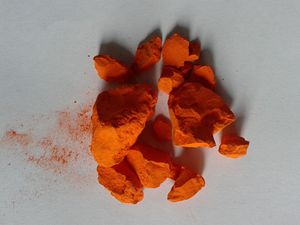Lead(II,IV) oxide
 |
This article is a stub. Please help Sciencemadness Wiki by expanding it, adding pictures, and improving existing text.
|
Lead(II,IV) oxide, more commonly known as minium, red lead or triplumbic tetroxide or simply lead tetroxide, is a bright orange-reddish crystalline or amorphous oxide of lead, with the chemical formula Pb3O4.
Contents
[hide]Properties
Chemical
Lead(II,IV) oxide does not dissolve in water and does not hydrolyze. When heated to 500 °C, it decomposes to lead(II) oxide and oxygen.
- 2 Pb3O4 → 6 PbO + O2
Nitric acid dissolves the lead(II) oxide component, leaving behind the insoluble lead(IV) oxide:
- Pb3O4 + 4 HNO3 → PbO2 + 2 Pb(NO3)2 + 2 H2O
Physical
Lead(II,IV) oxide is a deep orange-reddish compound, insoluble in water. It is quite dense, 8.3 g/cm3. It is insoluble in water but soluble in hydrochloric acid.
Availability
Minium can be found as a mineral, but it's rare. Red lead was available in past as a pigment, but since most lead pigments have been phased out in the favor of lead-free ones, it is difficult to be found today. Lead tetroxide can be bought as red lead from US Pigment.
Preparation
Lead(II,IV) oxide is prepared by the calcination of lead(II) oxide in air, at about 450 °C:
- 6 PbO + O2 → 2 Pb3O4
A less energetic way is by mixing potassium plumbate (which can be obtained by reacting lead dioxide with potassium hydroxide) with lead acetate, yielding yellow insoluble lead(II,IV) oxide monohydrate, Pb3O4·H2O, which can be turned into the anhydrous form by gentle heating:
- K2PbO3 + 2 Pb(OCOCH3)2 + 2 H2O → Pb3O4·H2O + 2 KCH3COO + 2 CH3COOH
- Pb3O4·H2O → Pb3O4 + H2O
Projects
- Thermite
- Lead dioxide preparation
- Lead(IV) acetate synthesis
Handling
Safety
Red lead is soluble in hydrochloric acid, such as gastric acid, and therefore it can be absorbed in the organism easily, making it extremely toxic. It should be handled with proper protection.
Storage
Lead(II,IV) oxide should be stored in closed bottles, with a hazardous chemical label.
Disposal
Minium should be taken to the proper disposal facilities.
